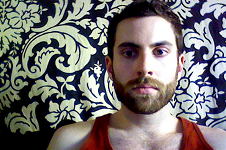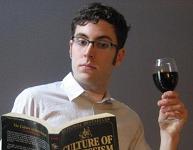 The majority of New York based artist Enid Crow‘s photographs contain little more than a tightly cropped self portraits of the artist wearing different costumes and posing. Despite the seemingly simple and repetative nature of her work, Crow has managed to create a body of images that says quite a bit about American culture and politics.
The majority of New York based artist Enid Crow‘s photographs contain little more than a tightly cropped self portraits of the artist wearing different costumes and posing. Despite the seemingly simple and repetative nature of her work, Crow has managed to create a body of images that says quite a bit about American culture and politics.
————————————————————————-
Jon Miller: What initially drew you to self portrait photography?
Enid Crow: Around 1979, my parents sent me to the Wendy Ward School of Charm. I took classes from when I was eleven until I was about thirteen. In addition to learning things like how to answer the phone and good grooming, part of charm school is learning how to be a fashion model. This involved collecting photographs of good poses from magazines, going to the front of the class, and posing like the model in your photograph. Then we were supposed to get professional black and white photographs taken and start making fashion model portfolios. My mother seemed to think this was either a scam or totally pointless since I had a mouth full of braces and bad skin.
So, I made my own studio in the basement by taping white paper over the wood paneling and photographed myself with my mouth closed, copying poses of the fashion models in Better Homes and Gardens. That was the only magazine my mother subscribed to. When I was a drama student in college and grad school, I started acting as characters in the self-portraits and working with costumes more.

JM: Your early series, “Disasters” features characters on the brink of, well, disaster. Their faces all share a similar look of fear, shock, and disgust. In contrast, your newest series, “Happy Workers”, is nothing but smiles and happy faces. Clearly, these images comment on disaster as well, but on a more subdued and personal level. What are your thoughts on this shift in the way your ideas are presented?
EC: After photographing all the tragedy in Disasters and in the midst of the financial collapse last year, I needed to photograph something to cheer myself up. So I photographed myself as people who still have their jobs. Granted the characters in my photographs don’t have health insurance and their 401(k) plans tanked, but at least they aren’t working in a child factory in China. America really knows how to treat its workers!
Seriously, in my pictures, I try to address social issues like sexism, homophobia, and the exploitation of workers. Often I think a strong way to get a point across about a painful, controversial topic is to use humor. So in that sense, I haven’t shifted too far from Disasters even though my facial expression has changed and I’m now using text beneath the photographs to help tell the story.
JM: I love your “Faggots” series in which you and your real life partner at the time play the roles of queer men, in both graphically sexual moments as well as quieter and even mundane situations. Though you had been doing drag self portraiture as men for some time, this series seems to have developed later and contains the only overt sexual imagery in your catalog. What inspired these images?
EC: When I first came to New York City in 2000, I worked for an attorney who has an extensive photography collection of men loving, taken from the latter part of the 19th century to today. The International Center of Photography featured some photographs from his collection in a show in 2001. My boss would show me new pictures as they were sent to his office and I’d see them scattered around his desk when I delivered papers for him to sign. The subjects ranged from stiff studio portraits of male couples, men sharing beds in rooming houses, to beefcake pictures from 1970s porn magazines. So in my series, I tried to reflect the scope of the images that I saw in his collection.
JM: Queer sexuality in art is almost automatically processed as transgressive and political. What were you trying to say in creating this work?
 EC: Faggots is my favorite series. Justin Duerr, my ex-boyfriend who plays my lover in all the pictures, helped me shoot some of the pictures in the Disaster series around 2005 and 2006. Justin is bi and he would get aroused and want to kiss me when I was dressed as a male character for Disasters. We decided scenes of us kissing as men would make interesting photographs themselves so we started our own series together and ended it just before we broke up in 2008 when I decided to grow my hair long.
EC: Faggots is my favorite series. Justin Duerr, my ex-boyfriend who plays my lover in all the pictures, helped me shoot some of the pictures in the Disaster series around 2005 and 2006. Justin is bi and he would get aroused and want to kiss me when I was dressed as a male character for Disasters. We decided scenes of us kissing as men would make interesting photographs themselves so we started our own series together and ended it just before we broke up in 2008 when I decided to grow my hair long.
The photos comment on issues that I care about very deeply—the arbitrariness of gender and homophobia. I don’t think there’s any need for me to get into a long soap box sermon about why those issues matter because this is, after all, Gaycondo. But briefly, being in love with someone who loves men, and knowing he could engage in certain social rites with me because I am a woman (like marry me or display my photo at work) but not a man he might fall in love with after me, is in my mind, one of the greatest social tragedies there is.
JM: Any future projects currently being fleshed out?
EC: I am going to my parents’ condo in Florida in a week for a vacation. I am going to finish the Happy Workers series and start shooting a very short self-portrait series called Beauty Queens in tiaras and heavy makeup on the beach. In December, I am going to start shooting a series of portraits of vegans in New York City. I would also like to do a serious series of pigeon photographs. I love pigeons and I take a lot of snapshots of the cute ones I see on the street and the sick ones who I take care of in my apartment.
JM: Pigeon photographs? That seems like a pretty grand departure from your regular aesthetic! What type of images are you planning on creating?
EC: I am as fanatical about pigeons as Nikola Tesla, and these pictures will be like poems in their honor. I will take photographs of ordinary street pigeons loafing and flying and manipulate the images so that they are monochromatic and simple. Then I will take the individual, simplified versions of pigeons and use them as individual design elements, like the way the artist Tae Won Yu manipulates letters of the alphabet to make fancy designs. I have been doing this a little with pictures of pigeons I’ve found on the Internet, but I think the pictures will be better if I start from scratch with my own pictures.
But I am not moving away from self-portraits. Sometimes I just need a break to come up with a new idea. As I age, my face is getting saggier and more comic, so I think that the photos will probably get funnier and sadder.
For More: www.enidcrow.com
—————————————————————————–
26 Interviews by Jon Miller
365 days.
26 interesting people.
1 alphabet.







































































